Pat Ranfranz
Search for his uncle's Missing In Action (MIA) B-24J Liberator 44-40598 off Yap
Pat Ranfranz was always interested in aviation and has created two outstanding websites, CharlesLindberg.com and MissingAirCrew.com on his own initiative and funds, traveled to Yap Island to search for his uncle, John R. McCullough Missing In Action (MIA) aboard B-24J Liberator 44-40598.
|
|
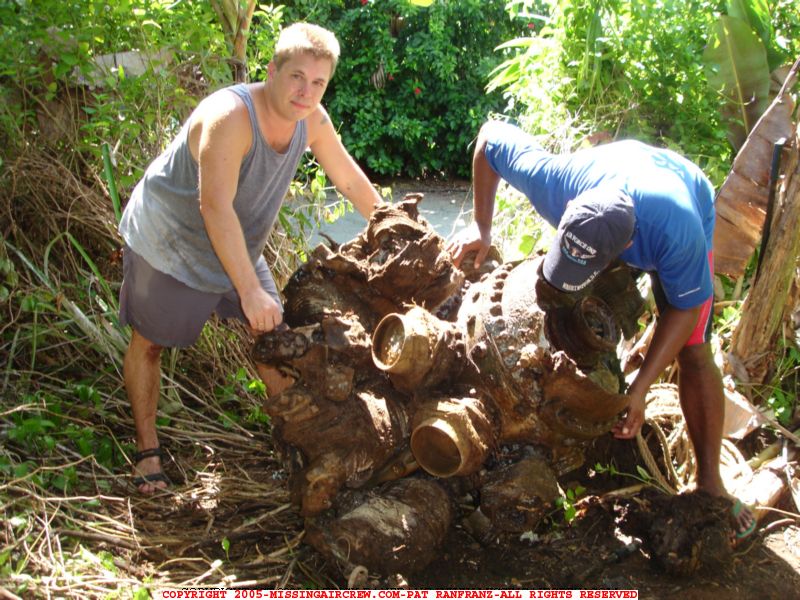
Pat Ranfranz at F4U
|
Tell a little about yourself and your interest in WWII
I'm originally from Rochester, Minnesota and went to college at the University of Wisconsin Eau Claire. I have a BS in History & /Anthropology Degree. I have lived in Shoreview, Minnesota (a Twin Cities suburb) since 1989 with my wife of 18 years, Cherie, and 16 year old daughter, Genna. I have always been interested in history and aviation. As a child I remember hearing about my uncle, John R. McCullough was lost over Yap Island during WWII.
It always intrigued me to find out more information about my uncle and what it must have been like to fight the air war in the Pacific. While growing up in the 70’s my older brother and I spent countless hours watching war movies, the old TV series Baa Baa Black Sheep, and building WWII plane models. However, most of the models ended up being destroyed in the backyard with firecrackers as we simulated WWII missions. Another uncle (Skip Caldbeck) had a few small planes and a grass air strip on his farm near Rochester, Minnesota. He took me and my brother on our first flight over his farm when I was in grade school. My eye was always to the sky watching small planes after this experience. Although I had to wait a few years after my first flight, I received my private pilot license in 2001 and purchased a small Cessna 152 with my wife. My wife is currently a student pilot. In addition, during college I completed my senior thesis on the development of air power and started my research regarding my uncle and his missing B-24 crew. Although my career path took me into educational publishing, I have always had an insatiable appetite for anything related to the air war during WWII such as books, videos, TV documentaries, etc. I have tried to read every book on the subject!
|
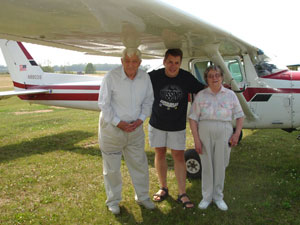
Pat Ranfranz with
307th BG vet George
Cresswell and his wife
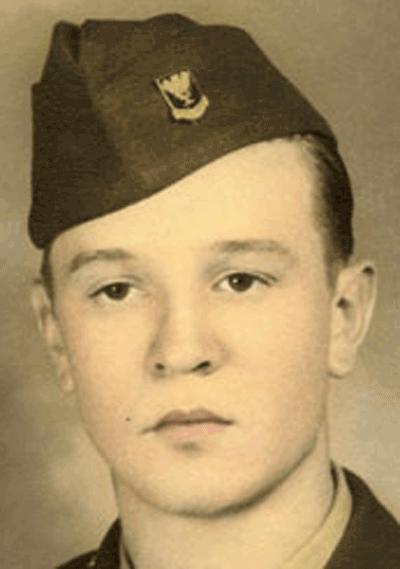
John R. McCullough
|
Talk about your Charles Lindbergh Website
I created the CharlesLindbergh.com web site in 1999 after reading the Pulitzer Prize biography Lindbergh by A. Scott Berg. I went searching for more information on the web and was surprised to find the web lacked a comprehensive site about the life and times of Charles Lindbergh. I decided to utilize my web development knowledge to create a comprehensive Lindbergh web site.
My goal in creating and maintaining the site has been to develop a comprehensive web site dedicated to the history of Charles Lindbergh and related topics. It’s not a hero worship site. I’m fascinated with the history of Charles Lindbergh and feel the man had both good and bad qualities. The bottom line is that Lindbergh was involved in so many historically important events during his lifetime. Researching Lindbergh’s life is like reading about the who’s who of the 20th century.
CharlesLindbergh.com web site has never been a money making business but one of my hobbies, however, the site receives over 80,000 yearly visitors from around the world. I no longer have the time to keep up with all the contacts that flow in from the CharlesLindbergh.com web site but the site keeps moving along due the content I created over the years and the Lindbergh discussion forum.
Outside of my interest in anything related to history and aviation, I was never sure why I started the CharlesLindbergh.com web site; however, the dots were connected when I received a letter from Dick Beardon, a member of the 307th Bomb Group (same as my uncle). He wrote that Charles Lindbergh was on the same islands during the same timeframe as my uncle. The middle-aged Charles Lindbergh traveled to the Pacific as an observer, and eventually ended up flying over 50 combat missions, including one in which he downed a Japanese aircraft.
The Roosevelt Administration tried to ban Charles Lindbergh from the military and related industries due to his noninterventionist activities prior to the Japanese attack on Pearl Harbor on Dec. 7, 1941. Lindbergh resigned his commission in the Army Air Corps after Roosevelt publicly denounced him. He tried to reenlist after Pearl Harbor but his request was refused. He then served as a technical adviser and test pilot for the Ford Motor Company and United Aircraft Corporation.
Lindbergh flew over 50 combat missions and shot down a Japanese plane before being asked by the military to return to the US. The letter I received from Mr. Beardon explained that he and many B-24 crew members owed their lives to Lindbergh because he developed cruise control techniques that demonstrated how to significantly extend the range of fighter planes during the summer of 1944. Lindbergh's information helped fighters fly farther and stay with the bomber formations longer thus protecting them from Japanese attacks.
Unfortunately, Lindbergh's cruise control techniques were not able to help my uncle’s B-24 crew. Their 307th Bomb Group mission to Yap Island on June 25 1944 was without the protection of US fighters and was un-escorted to Yap Island via a 13 hour round trip (one of the longest missions of the entire war). Even with the new cruise control techniques, American fighters never had the range of a B-24.
|
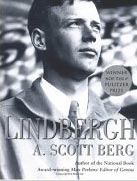
Lindbergh
by A. Scott Berg
|
Talk about the MissingAirCrew.com
I created the MissingAirCrew.com web site to post my research about my uncle and location additional information to help locate the men and bring them home. The site is dedicated to the memories of the ten crew members of the Coleman B-24 Crew (13th Air Force, 372nd Bombardment Squadron, and 307th Bombardment Group) who were shot down by a Japanese fighter over Yap Island and declared missing and non-recoverable on June, 25, 1944. My uncle, T/Sgt John R. McCullough, was the Assistant Radio Operator on the MIA B-24.
Although it's been sixty years since the plane went missing, I feel it's still important to search for the crew and provide closure for the families. The military consistently states that we will never leave men behind after conflicts, however, thousands of men from WWII are still missing and can be found if resources are applied to the search effort (78,000 servicemen from WWII are still missing in action). The veterans from SE Asia have had a much louder voice over the years to locate men from the conflicts of the 60’s and 70’s while missing men from WWII have not received the same attention and focus. This is due to a number of factors including the start of the cold war right after the end of WWII.
I believe that my uncle and the other members of the Coleman crew should not lie anonymously in the waters near Yap Island without a search. Their bodies never have been found and their families never have known the peace of closure. The MissingAirCrew.com web site is my vehicle to document my research, find out more about the lives and times of the Coleman Crew members and to find the resources to locate the missing crew! Although technology was an obstacle years ago to locating water crash sites years ago, it no longer stands in the way. It’s only the access to the technology and the price to use it that hinders my ability to locate my uncle and his crew.
|
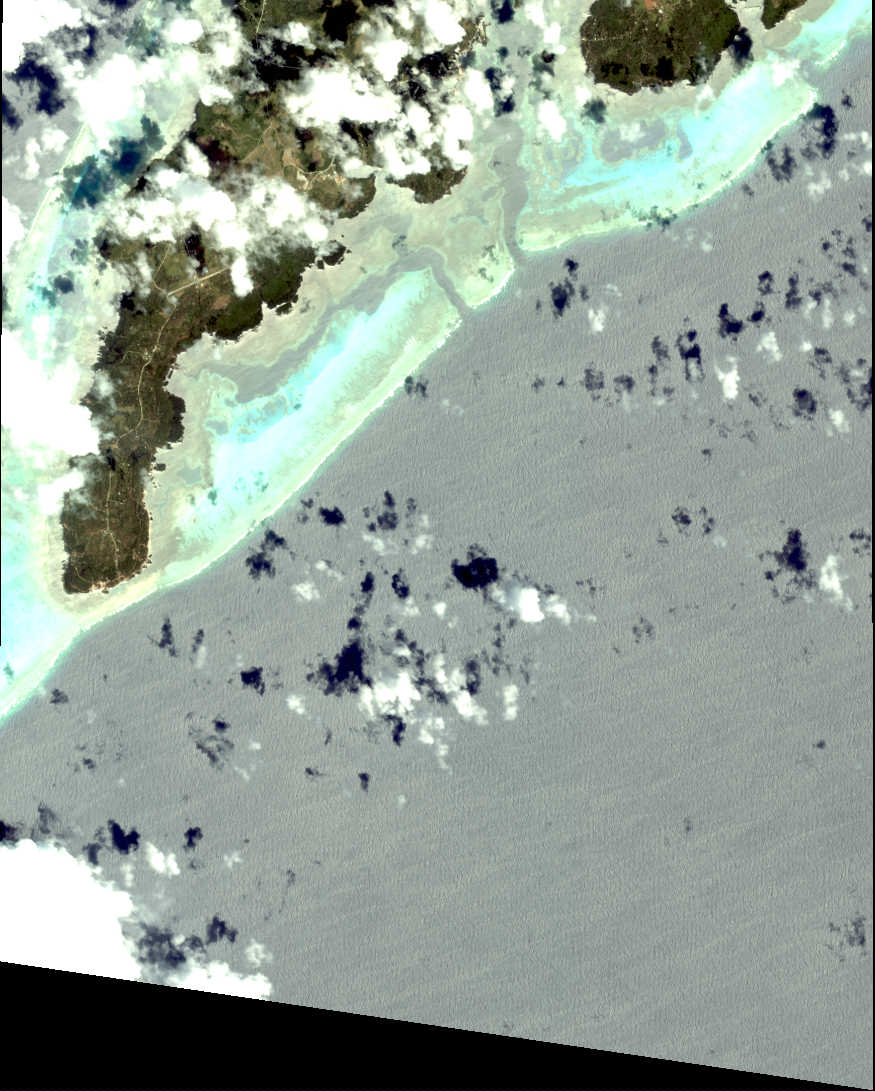
Southern Yap
Satellite View
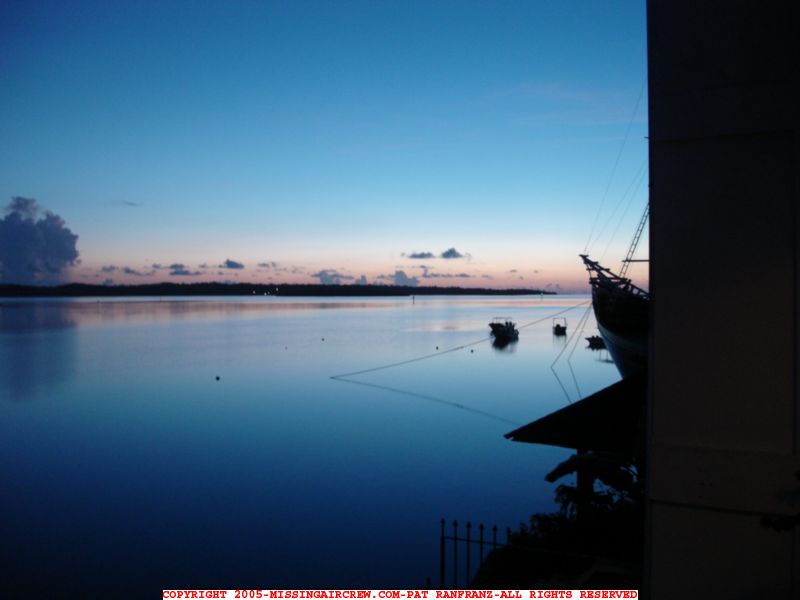
View of southern Yap
|
What got you interested in Your Great Uncle's MIA Case
I started my search for my uncle, T/Sgt John R. McCullough, and his fellow Coleman crew members in 1988 while finishing my History degree at the University of Wisconsin, Eau Claire. While growing up I heard stories about my uncle who was shot down and never recovered during WWII. My uncle, John, was one of 13 children from a 1400-acre Watertown, South Dakota farm family. In 1942, shortly after Pearl Harbor, the family moved to Covina, California to help with the industrial war effort. My mother was 5 years old at the time of the move. Throughout the years our family had only limited information about the shoot down off Yap until I started my research in the late 80’s. As I stated above, I've always had a strong interest in history and aviation therefore, the story of my lost uncle stayed with me. Although I have never been terribly close to a lot of my living relatives, my missing uncle fit into my fascination with aviation and history. Whenever I was near a globe I would spin it around to view Yap in Micronesia. The tiny island of Yap is often found on globes due to their fame with stone money. I can recall pointing to Yap in grade school on a globe and trying to explain that I had an uncle who was shot down over the island.
After developing and launching my MissingAirCrew.com web site in 2004 I was able to locate a number of relatives of the other crew members through the internet. The first contact was from Martin B. Unger’s (Navigator) sister, Cecile. She received her first computer and was entering family names into a search engine with her niece. They entered Martin’s name and were shocked to see my web site come up with a picture of Martin on the splash page. Cecile said her hair stood up as she stared at the computer and Martin’s picture. On April 4, 2005 I met Cecile in New York City for the first time and spent 4 wonderful hours sharing information and talking about the families and the crew. Since this first meeting I have returned to New York City two additional times to meet with Cecile, her sister, and the Pearl (Martin’s widow). In addition, to Martin’s family I have been in contact with two nephews of the Co-Pilot, John E. Jurica Jr., and have been contacted by other crew families. All the families share the same desire for more information and closure.
|
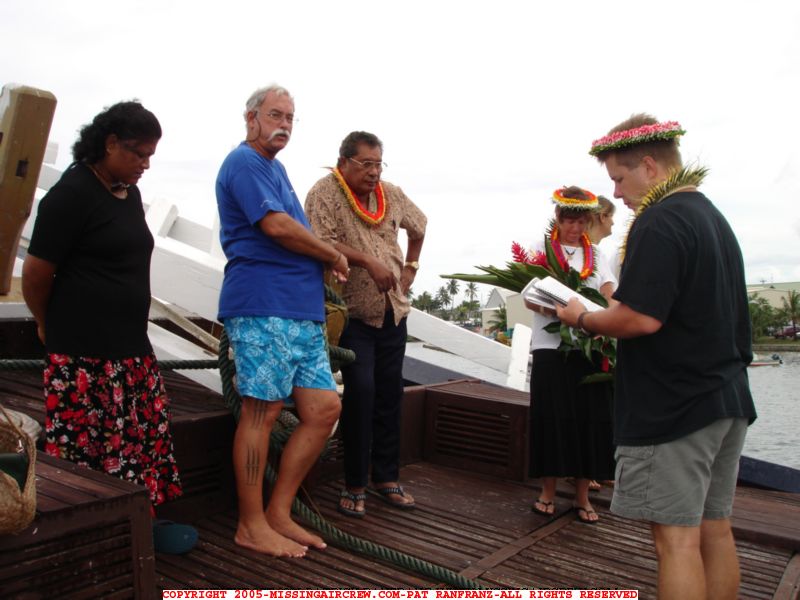
Coleman crew memorial
service on Yap Island
|
Why did you decide to search for the B-24 yourself?
After researching information about my uncle since the late 80’s I decided to take matters into my own hands and attempt to search for the men and plane and document the history before it was lost in time. Due to the water location of the crash site I was advised that JPAC and other government agencies would likely not get involved with my case. Although 78,000 men are still listed as MIA from WWII, not a lot of resources are put into searching for the missing men (especially water cases) unless a definite location of human remains is located and documented.
I have been talking about traveling to Yap to search for my uncle for years but last year with the development of the MissingAirCrew.com. I decided to make the commitment and go search for the plane myself regardless of the cost. My wife of 18 years, Cherie, has always been interested in my missing air crew project and has helped me with my project throughout the years. She has spent countless hours with me going through rolls of microfilm and other documents we have received. She was more than willing to get certified as a diver and travel to Yap to help with the search. Cherie and I do almost everything together so it was not a big stretch for Cherie to decide to go with me to Yap. We worked with Cindy Harris from the MDA Travel Desk in Guam and Bill Acker the CEO of the Manta Ray Hotel in Yap to plan the trip. Both Cindy and Bill were extremely helpful and went out of their way to help us plan the trip. When we arrived at the Manta Ray hotel in Yap we had a meeting with Bill’s hotel staff to plan our daily search activities. We hired dive guides and land guides from the Manta Bay Hotel to help us throughout the week. We realized the chance of finding my uncle’s plane on the first trip without equipment such as side scanning sonar and other underwater equipment was slim therefore our goal was to do a reconnaissance mission to document information about the possible location of the plane through interviews with Yapese elders before it’s too late (it’s rare for Yapese to live into their 80’s). Although the chances of finding the plane by diving were slim, we still planned dives for each day to try and locate the plane. Most days during the trip we completed two dives each morning, returned to the hotel by noon, and then went out into villages to interview Yapese elders who lived on the island during the war. The Manta Ray Hotel staff helped us located elders throughout the island to interview including some of their own relatives.
|
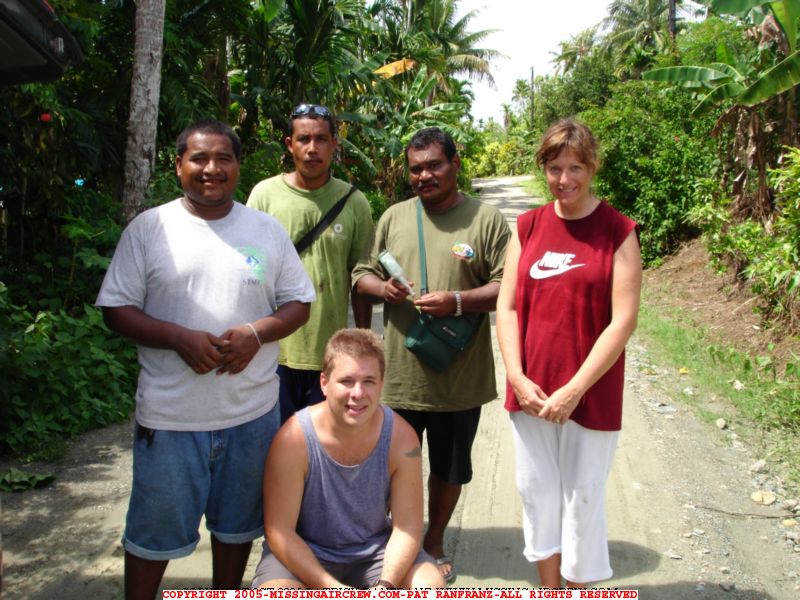
Ranfranzs on Yap
at F4U crash site
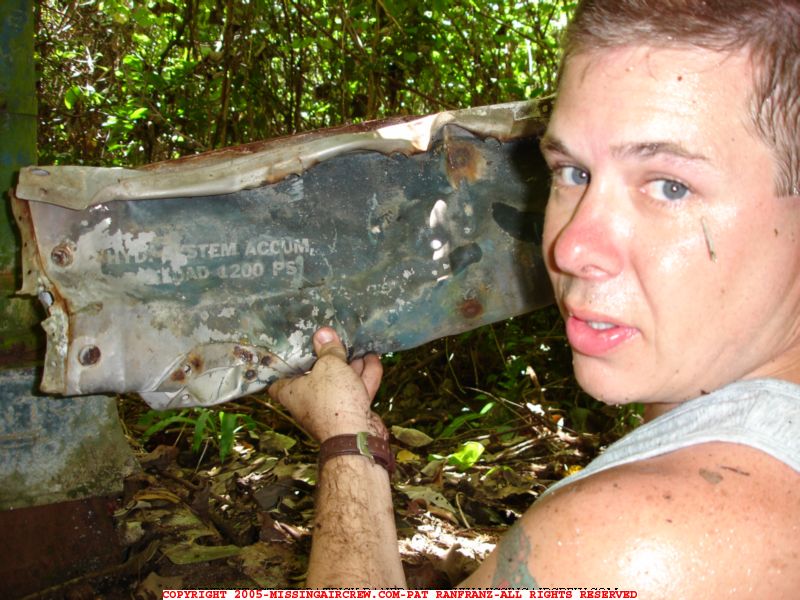
Ranfranz on Yap
with F6F wreckage
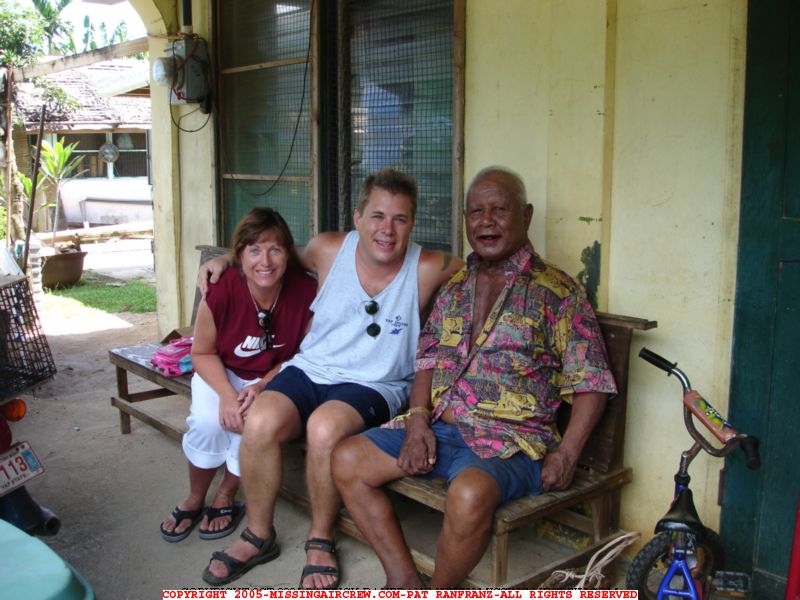
With elders on Yap
|
Tell about your trip what did you find in terms of history?
We spent an exhausting week on Yap Island (October 2005) searching for the Coleman B-24. Although we did not find my uncle’s plane (the Coleman B-24) on the first trip, we came home feeling like we accomplished a lot during the trip. While on Yap we were going non-stop interviewing Yapese elders, hacking through jungles, crawling through mangrove swamps, and diving the waters around the Yap reef. We were very surprised to locate the wreckage of three American planes including two Hellcats and an F4U Corsair. We originally thought the Corsair wreckage could have been part of a B-24 but we positively identified the individual pieces of wreckage as parts from a F4U Corsair after returning home. In addition, one of the elders we interviewed advised that he helped pull the American pilot out of one of the Hellcats and helped bury him on a hill near the plane. This same elder provided information about the desecration of another Hellcat’s pilot’s body after the Japanese pulled his lifeless body out of a wrecked plane. We have shared this information with JPAC and others and hope the pilots of these crash sites will be recovered. Pictures of crash sites investigated.
Not finding my uncle’s plane on this first trip was by no means disappointing since we hope to provide other families with closure to their missing air crews. Upon finding the other American crash site we immediately decided to expand our mission to document all American crash sites on and near the island. Since returning from Yap I have created a comprehensive list of all American planes lost near Yap.
On Wednesday, October 26, 2005 we held a memorial service for the Coleman crew on the bow of a ship called the Mnuw in the Yap Island harbor. We gathered with several new friends, our land and dive guides and Yapese chiefs (Andrew Ruepong, Paramount Chief of Yap and Chief of Rul, Bruno Tharngan, Chairman of the Council of Pilung and Chief of Ma'ap and Martin Yinug, FSM Supreme Court Justice) to pay our respect to the Coleman crew. The service was filmed and will be shared with the families of the other crew members.
We conducted a lot of interviews with Yapese elders while on the island including two men who thought they saw the Coleman plane shot down and crash near the Yap harbor on the east side of the island. I now believe their accounts are most likely about the Anthony crew who were shot down on 10 August 1944. The most interesting information from the witnesses is that they both reported seeing 2-3 parachutes come out of the plane. Both recounted that two American POWs were captured and interrogated by the Japanese. Later, according to both Yapese men, these same two American POWs were taken to the island of Palau along with two Catholic Priests and a Filipino man (and his family) who ran the weather station on Yap. Once again, since returning from Yap we now believe the parachutes and the POWs were likely from the Anthony B-24 crew, not my uncle’s Coleman crew, who were shot down over Yap on August 10, 1944.
In addition, Pat Scannon and his BentProp Project have been involved on the Yap POW research and have additional evidence to suggest that the Yap POWs associated with the Catholic priests are likely men from the Anthony crew. Yap Additional Info and Yap Missions.
|
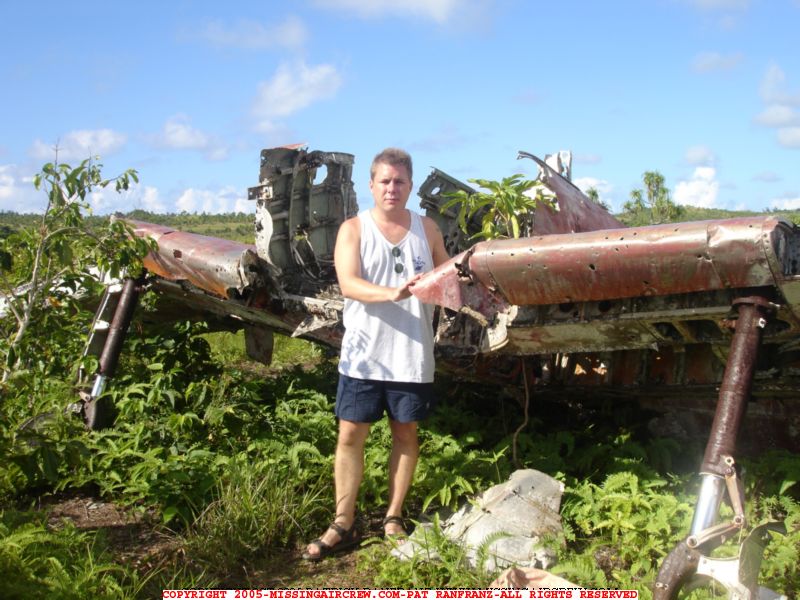
Ranfranz with Zero
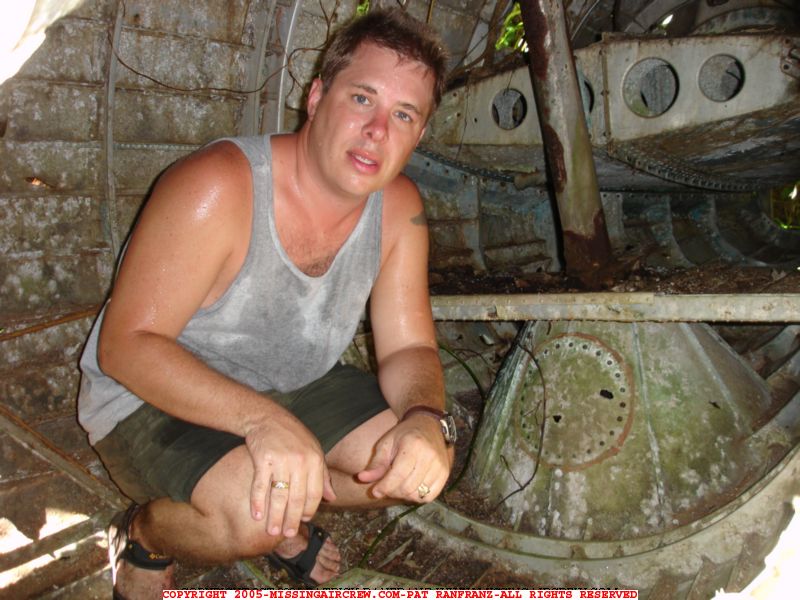
Ranfranz with L2D
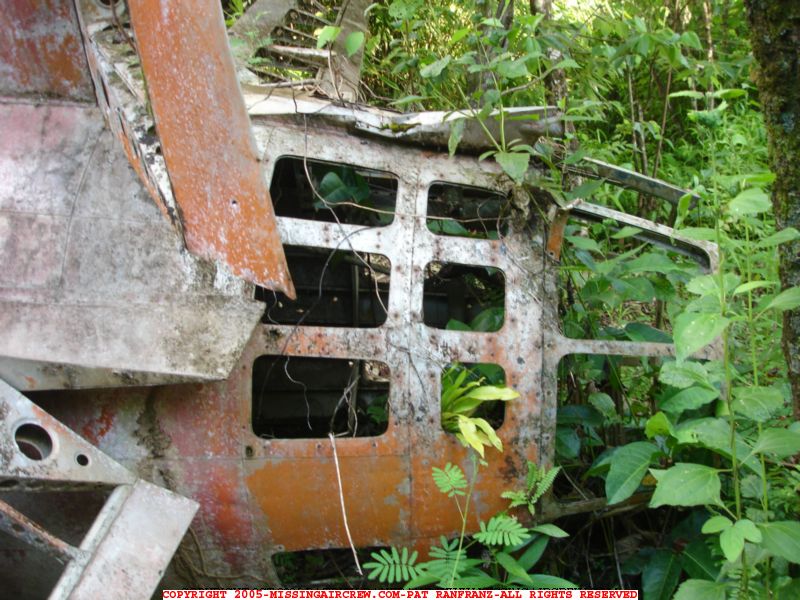
G4M Betty
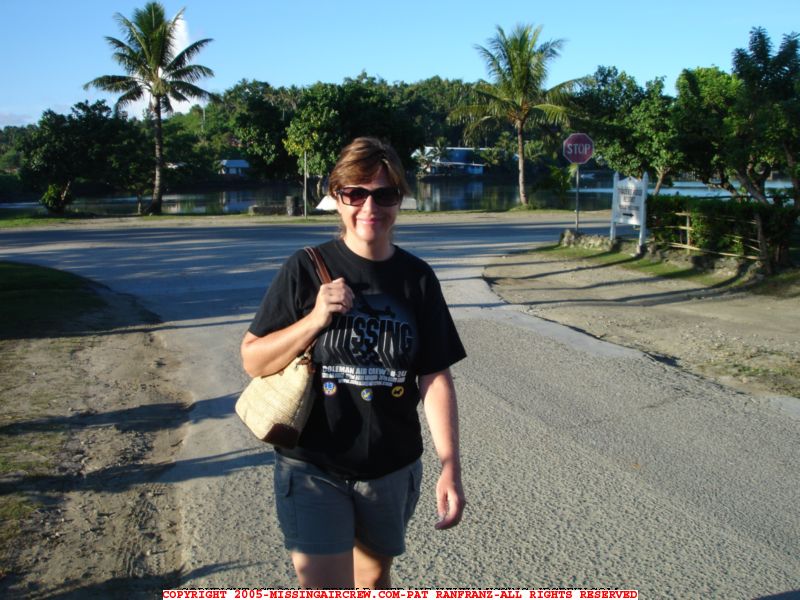
Searching on Yap
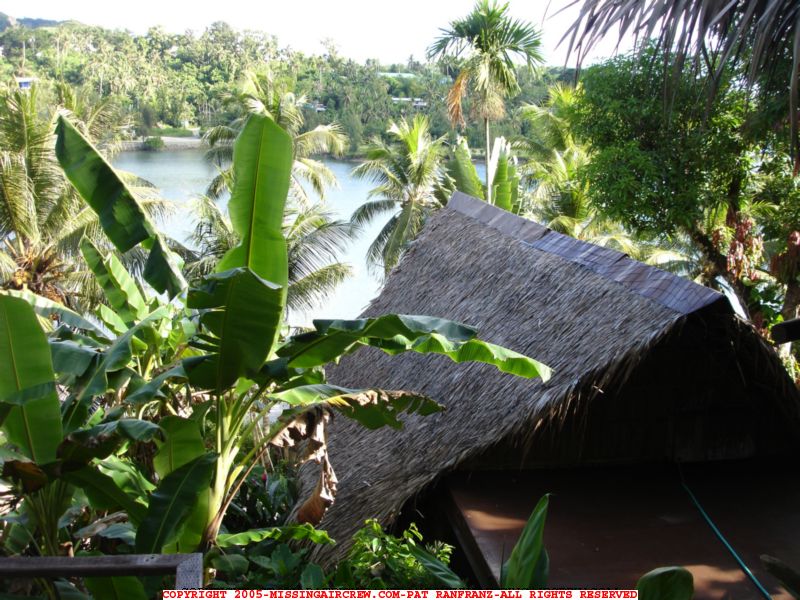
Yap Views
|
Although we did not focus on Japanese wrecks, including Zeros, a Betty Bomber, and a Tabby-Showa/Nakajima L2D transport plane. Unlike the American crash sites we located, the Japanese wreck sites we visited were known by the hotel staff and local villagers and located near the old airport. Many of the planes had been destroyed on the ground during American raids. The Japanese wrecks near the old airport seem to be a common tourist location. We received information about the location of a number of additional Japanese wrecks in remote areas and plan to visit these wreck/crash sites on our next trip to Yap. Some of the planes are located in mangrove swamps and water locations.
In short, we plan to put all our energy into returning to Yap in the fall of 2006 to locate the Coleman crew and continue our mission to document all American crash sites on the island. I hope to be able to gain access to side scanning sonar, underwater cameras, and other underwater resources; however, the cost is often the issue. I have found a few reasonable priced side-scanning sonar units around the $5000 price range but when you add in the cost or travel to Yap it becomes a very expensive search trip. In addition, a few people have offered to join us on Yap next fall to help with the search. One person who has offered to join us is looking into purchasing a side-scanning sonar unit to bring along on the trip. It would be very helpful to identify targets before we dive. We found out how hard it was to locate a plane in the water last fall when we completed two dives each morning. There is a lot of water around even a small island such as Yap. Although a B-24 is not a small plane, it’s like looking for a needle in haystack when you get into the water. Pictures and information from our October 2005 search
While on Yap we went diving most mornings to search for my uncle’s plane [B-24D 42-40598], however, we were not 100% sure of the location of the plane. In addition, we received information from interviewing Yapese elders that a bomber was shot down and sunk near the 2nd channel off the main Yap harbor. We mistakenly thought this might have been my uncle’s plane therefore; we spent time diving this area rather than further south where I now believe my uncle’s plane is located.
The bomber off the second channel near the harbor is most likely the Anthony crew B-24 lost on 10 August 1944. In addition, diving the waters without the use of side scanning sonar to identify targets is like looking for a needle in a haystack. We really need to find away to gain access to side scanning sonar if are going to find my uncle’s plane and the other American planes inside and outside the reef. In addition, since returning from Yap I have now identified all the American planes lost on or near Yap therefore, we will have a much better idea of what we are looking for on the next trip.
For example, we have three B-24’s from the 307th Bomb Group that we might be able to locate near the island using side-scanning sonar and then diving. Then again, it’s possible all three planes are too far out in deep water and we might never find them without complex sonar units and underwater vehicles. Unfortunately, locating my uncle’s crew and the other American planes on Yap is not as glamorous as searching for the Titanic or Emilia Earhart’s plane off Howland Island therefore, it’s been somewhat difficult to get others involved. I still hope that some individual or group will get involved with my search project and provide the expertise and resources needed to locate the plane. I think my search project would be a fantastic History Channel or Discovery Channel series or special. I’m just not sure how to drive the project in this direction or to get the attention of the people who have the top end search equipment. It would be a dream come true to get some top-end researchers and resources involved in the search for the Coleman crew.
Talk about your new research and new conclusions
Since returning from Yap I have been able to document all the American planes lost over or near Yap. This has helped us identify the bomber that was shot down and sunk off the second channel of the harbor as the Anthony crew as well as solid information about the location of the Coleman crew crash site. Mark Swank, a researcher from the Washington, D.C. area, provided transcripts from a submarine that was patrolling off Yap Island as a lifeguard during the AAF missions. The USS Albacore was offshore the morning of June 25, 1944 and watched the bomber formations approach Yap and bomb the island. The sub had to submerge often due to the Japanese aircraft in the area, however, shortly after hearing explosions and seeing fires on the island the sub received word that two B-24’s were going down. My uncle’s plane was going down south of the Yap air strip and another plane was going down near Soral Island (95 miles away). Unfortunately for my uncle’s crew, the sub decided to go after the plane near Soral and did not return to Yap until late in the evening of June 25th. The sub spent the next four days searching for the crew. A number of B-24 crews were rescued by subs off Yap Island during the summer of 1944. Often crews spent days in the water before the subs were able to locate the individual life rafts. In short, the U.S.S. Albacore war patrol report record has helped me identify the Coleman crew location as south of the old air field and harbor. Using other reports such as the 307th Bomb Group mission report, the Missing Air Crew Report, and the 5th Bomb Groups statement that the Coleman crew “ crashed just outside the reef south of the island” we now feel we have a solid location to search this fall near the SE tip of the island.
While on a business trip last December during the holiday season I took my wife and daughter along and extended the trip so we could meet with the family of Martin Unger (Navigator from the Coleman crew). We had a wonderful evening presenting my Coleman crew research and pictures from my Yap search trip to the sisters and widow of Martin Unger. This was my third meeting in NYC with Cecile (sister of Martin) and second meeting his other sister Leona and Martin’s widow, Pearl. The Unger family has shown a lot of interest in my project and I have enjoyed keeping them up-to-date on my efforts In addition, I enjoyed meeting Justin Taylan from PacificWrecks.com discussing our mutual interest in pacific crash sites. I’m looking forward to working with you moving forward to help provide information and resources to locate the Coleman crew and other planes on or near Yap Island.
What are your Future Goals?
We plan to return to Yap in late September or October to continue the search for my uncle’s plane. A few people have offered to accompany us including someone who is looking into purchasing a side-scanning sonar unit. In addition, I’m trying to locate additional resources to provide us with as much expertise as possible to locate my uncle’s crew and the other American crash sites. Obviously it would be very helpful to receive help from someone who has extensive underwater searching experience and access to equipment such as side-scanning sonar, ROVs, underwater camera’s etc.
Our goal is to locate and document as many crash sites as possible on Yap Island. The original goal of locating the Coleman B-24 has been expanded to locating and documenting all American crash sites on Yap to help provide closure to all families who lost men over Yap and to make sure the plane wreckage and oral history of the island is recorded before it is lost in time. Time is running out to interview Yapese and others who have memories of the events of WWII.
I would appreciate any help to locate resources, expertise, and funding to help locate the planes including side-scanning sonar, underwater cameras, ROVs, etc. Research help to continue to document the men and planes lost over Yap. For example, I know a lot bomb damage pictures were taken by photo planes of Yap Island during the war. Some of these pictures might help us locate some of the crash sites.
Help to get others involved in the search for my uncle’s crew as well as the thousands of other missing Americans from WWII. For example, I would love to get someone involved to create a documentary about the Coleman crew and the search for their plane. Any help will be greatly appreciated!
My goal is to document the crash sites and help bring the MIA men home. Although I enjoy going to air shows and museums to view WWII aircraft, I feel the planes that went down with men onboard should be considered a grave site therefore; they should remain where they crashed.
Although the US military often states they will never leave men behind, we have left thousands of men behind from WWII. We would never leave a US plane and its men in the waters off of Iraq if a plane went down today yet the government has limited resources and funding to recover men from WWII. I feel more can be done to locate the missing men from WWII. If my wife and I can take two weeks and ten thousand dollars of our own money to locate a number of crash sites on Yap, I can’t imagine what the U.S. Government could do if they applied their resources. Yap is only one of many examples of missing American’s that can be located if resources are applied. |

December 11, 2005
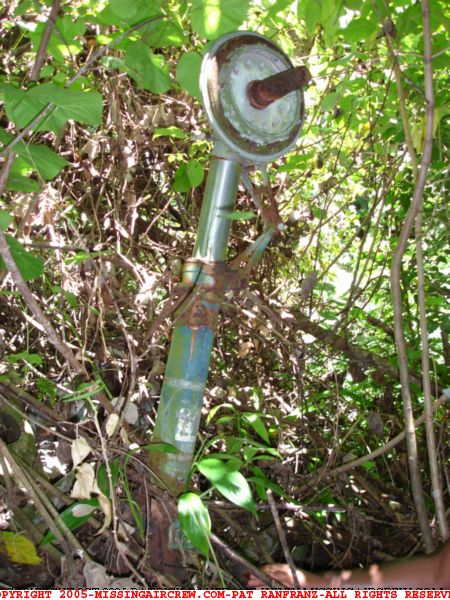
F6F Hellcat 58675
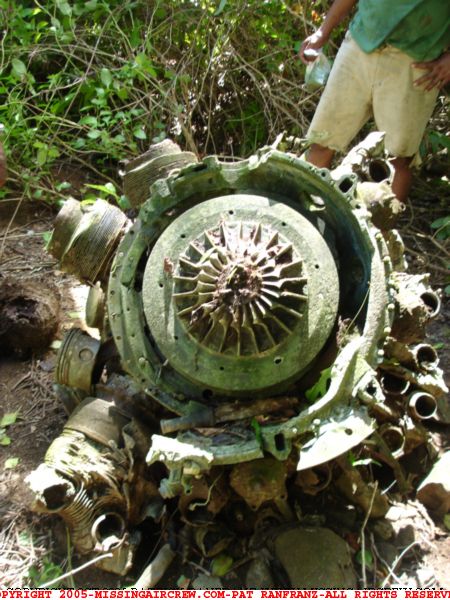
F4U Corsair crash
|
|